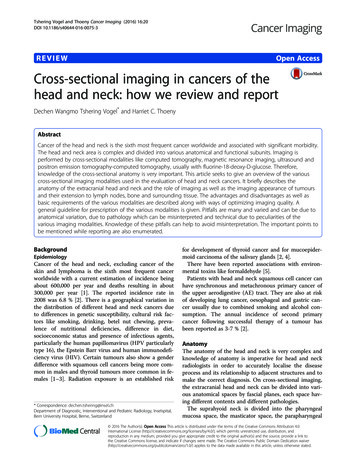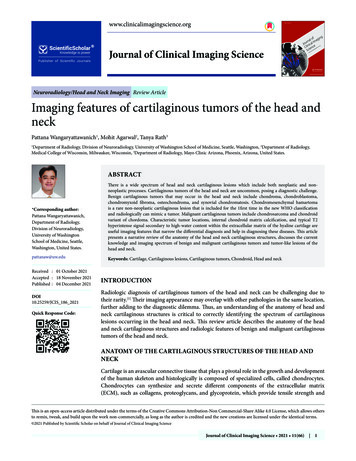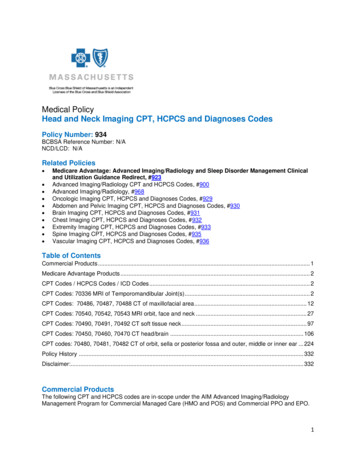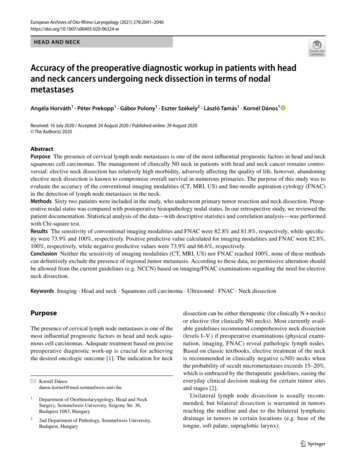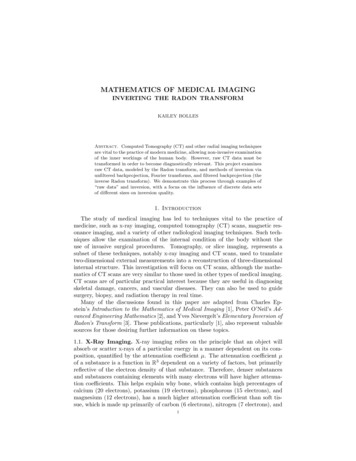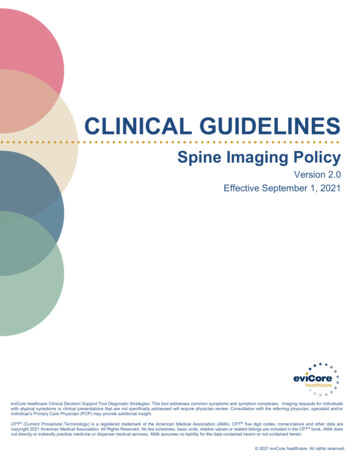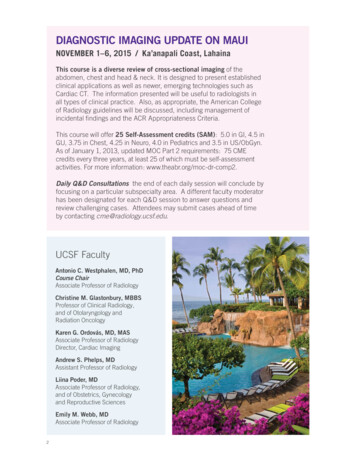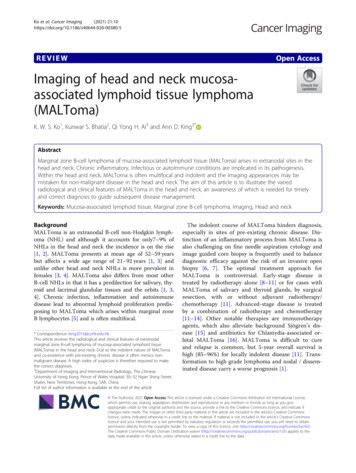
Transcription
Ko et al. Cancer Imaging(2021) IEWOpen AccessImaging of head and neck mucosaassociated lymphoid tissue lymphoma(MALToma)K. W. S. Ko1, Kunwar S. Bhatia2, Qi Yong H. Ai3 and Ann D. King3*AbstractMarginal zone B-cell lymphoma of mucosa-associated lymphoid tissue (MALToma) arises in extranodal sites in thehead and neck. Chronic inflammatory, infectious or autoimmune conditions are implicated in its pathogenesis.Within the head and neck, MALToma is often multifocal and indolent and the imaging appearances may bemistaken for non-malignant disease in the head and neck. The aim of this article is to illustrate the variedradiological and clinical features of MALToma in the head and neck, an awareness of which is needed for timelyand correct diagnosis to guide subsequent disease management.Keywords: Mucosa-associated lymphoid tissue, Marginal zone B-cell lymphoma, Imaging, Head and neckBackgroundMALToma is an extranodal B-cell non-Hodgkin lymphoma (NHL) and although it accounts for only7–9% ofNHLs in the head and neck the incidence is on the rise[1, 2]. MALToma presents at mean age of 52–59 yearsbut affects a wide age range of 21–92 years [1, 3] andunlike other head and neck NHLs is more prevalent infemales [3, 4]. MALToma also differs from most otherB-cell NHLs in that it has a predilection for salivary, thyroid and lacrimal glandular tissues and the orbits [1, 3,4]. Chronic infection, inflammation and autoimmunedisease lead to abnormal lymphoid proliferation predisposing to MALToma which arises within marginal zoneB lymphocytes [5] and is often multifocal.* Correspondence: king2015@cuhk.edu.hkThis article reviews the radiological and clinical features of extranodalmarginal zone B-cell lymphoma of mucosa-associated lymphoid tissue(MALToma) in the head and neck. Due to the indolent nature of MALTomaand co-existence with pre-existing chronic disease it often mimics nonmalignant disease. A high index of suspicion is therefore required to makethe correct diagnosis.3Department of Imaging and Interventional Radiology, The ChineseUniversity of Hong Kong, Prince of Wales Hospital, 30–32 Ngan Shing Street,Shatin, New Territories, Hong Kong, SAR, ChinaFull list of author information is available at the end of the articleThe indolent course of MALToma hinders diagnosis,especially in sites of pre-existing chronic disease. Distinction of an inflammatory process from MALToma isalso challenging on fine needle aspiration cytology andimage guided core biopsy is frequently used to balancediagnostic efficacy against the risk of an invasive openbiopsy [6, 7]. The optimal treatment approach forMALToma is controversial. Early-stage disease istreated by radiotherapy alone [8–11] or for cases withMALToma of salivary and thyroid glands, by surgicalresection, with or without adjuvant radiotherapy/chemotherapy [11]. Advanced-stage disease is treatedby a combination of radiotherapy and chemotherapy[11–14]. Other notable therapies are immunotherapyagents, which also alleviate background Sjögren’s disease [15] and antibiotics for Chlamydia-associated orbital MALToma [16]. MALToma is difficult to cureand relapse is common, but 5-year overall survival ishigh (85–96%) for locally indolent disease [11]. Transformation to high grade lymphoma and nodal / disseminated disease carry a worse prognosis [1]. The Author(s). 2021 Open Access This article is licensed under a Creative Commons Attribution 4.0 International License,which permits use, sharing, adaptation, distribution and reproduction in any medium or format, as long as you giveappropriate credit to the original author(s) and the source, provide a link to the Creative Commons licence, and indicate ifchanges were made. The images or other third party material in this article are included in the article's Creative Commonslicence, unless indicated otherwise in a credit line to the material. If material is not included in the article's Creative Commonslicence and your intended use is not permitted by statutory regulation or exceeds the permitted use, you will need to obtainpermission directly from the copyright holder. To view a copy of this licence, visit http://creativecommons.org/licenses/by/4.0/.The Creative Commons Public Domain Dedication waiver ) applies to thedata made available in this article, unless otherwise stated in a credit line to the data.
Ko et al. Cancer Imaging(2021) 21:10Page 2 of 8General imaging featuresPrimary siteOn all imaging modalities MALToma produces solitaryor multiple solid nodules which are usually homogeneous without cysts, necrosis or calcification (Figs. 1, 2,3, 4, 5, 6, 7, 8). Tumour margins are usually well-definedbut can be poorly-defined [7, 17, 18].Ultrasound (US) is often the first investigation becauseof the superficial site of the glandular tissues in the headand neck. MALToma is markedly hypoechoic (Figs. 1, 2,and 8a), may contain fibrous striations comprising finelinear echogenic strands or wider denser echogenicbands [17–20] (Figs. 1, 2, and 8a) and shows internalvascularity on colour Doppler [7] (Fig. 8b). Internal striations and vascularity prevent misinterpreting a markedlyhypoechoic MALToma for a cyst. Posterior acoustic enhancement is described [17–19] but is less frequentlyobserved following advances in post-processing US technology [18, 21]. US also guides the site of biopsy.Computed tomography (CT) and magnetic resonanceimaging (MRI) are complementary to US and providecomprehensive evaluation of the whole head and neckregion, encompassing all lymphatic, extra-lymphatic andnodal sites. MALToma is isoattenuating to mildly hyperattenuating [22], with mild to moderate contrast enhancement on CT [23, 24] (Figs. 7 and 8c). MRIprovides better soft tissue contrast than CT, allowing depiction of subtle tumours, especially in a background ofpre-existing chronic conditions that predispose to MALToma. The signal intensity of MALToma on MRI islow-intermediate on T1-weighted images, intermediatemildly high on T2-weighted images, very low on apparent diffusion coefficient (ADC) maps and shows moderate contrast enhancement (Figs. 3, 4, 5, and 6). TheFig. 2 Ultrasound of a 72-year-old man with right submandibularMALToma presenting as bilateral parotid and submandibular glandswelling for 6 months. The right submandibular gland showsreplacement by multiple small hypoechoic nodules of similar size(open arrows) separated by echogenic strands (arrows). Theappearance overlaps with that of Sjögren’s syndrome without adominant nodule to indicate this was MALTomaADC maps from diffusion weighted imaging (DWI) areespecially useful in lesion characterisation because headand neck lymphoma, typically shows greater restrictionof diffusion than most other cancers [25] or inflammatory processes [26] with an average ADC value of 0.65 10 3 mm2/s, although much lower values are reported[27, 28]. Dynamic contrast-enhanced MRI or dual-phasecontrast-enhanced CT can be helpful in lesion characterisation as MALToma exhibits earlier wash-in andhigher relative washout than benign tumours or inflammatory processes such as pleomorphic adenoma [29] orIgG4-related disease [30, 31]. Hydrogen-proton MRspectroscopy (MRS) is deemed less useful because similar degrees of choline elevation are found in MALTomaand benign lymphoepithelial lesions [32].The role of 18F-fluorodeoxyglucose positron emissiontomography (FDG-PET) in MALToma is controversial.Early reports suggest low detection rates due to lowFDG uptake of early-stage MALToma [33]. However, ina recent meta-analysis the overall detection rate byFDG-PET-CT was 71%, being especially high in headand neck (90%) [34].Nodal sitesFig. 1 Ultrasound of a 33-year-old woman with parotid MALTomapresenting as bilateral parotid gland swelling for 7 years. The parotidgland shows a dominant homogeneous very hypoechoic solidnodule that could be mistaken for a cyst (open arrow) against abackground of numerous small homogeneous solid hypoechoicnodules interspersed with echogenic strands (arrows)Nodal disease occurs in 21% of patients with non-gastriclymphoma [3]. In the head and neck, enlarged nodeswith typical lymphomatous features on imaging (roundshape, loss or eccentric displacement of fatty hilum, andmicronodular pattern on US [21]) are uncommon, although linear echogenic strands within hypoechoicnodes have been observed in MALToma [20]. On theother hand, numerous small nodes are frequently encountered, and these may have reactive features [35],making them difficult to diagnose on any imaging modality (Fig. 9).
Ko et al. Cancer Imaging(2021) 21:10Page 3 of 8Fig. 3 Magnetic resonance imaging of a 40-year-old woman with Sjögren’s disease and left parotid MALToma presenting with long-standingbilateral parotid swelling and 2 years increasing swelling on the left side. a Axial T1-weighted post-contrast image shows a moderately enhancing,homogenous lobulated left parotid mass (open arrow). Both parotid glands exhibit background changes of Sjögren’s disease. b Axial T2-weightedimage with fat saturation shows a left parotid mass with intermediate signal intensity (open arrow). Both parotid glands exhibit backgroundchanges of Sjögren’s disease. c Axial apparent diffusion coefficient (ADC) map shows markedly restricted diffusion (open arrow) with a very lowADC value of 0.64 10 3 mm2/s (white contour)Site-specific clinical and imaging featuresSalivary glandClinical featuresThe salivary glands are the most common site of MALToma in the head and neck (46.5 to 81%). The parotidgland accounts for 80% of these MALTomas but aslymphoma accounts for less than 4% of parotid tumoursit may be overlooked leading to unnecessary parotidectomy [36]. Patients present with localized swelling, facialnerve palsy is uncommon (4–15%) [37]. Sjögren’s diseaseis the major predisposing factor for MALToma; 20% ofpatients have underlying Sjögren’s disease [38] which increases the risk of MALToma by 44 times with a cumulative risk of 6% per year [39]. Less commonpredisposing conditions are systemic lupus erythematosus, rheumatoid arthritis and IgG4-related disease [40],which can manifest as chronic sclerosing sialoadenitis inthe submandibular gland [41].Imaging featuresSalivary gland MALToma presents as a solitary solidnodule/ mass in 35% of patients (Fig. 3) with imagingfeatures as described above. Multifocal disease is common, seen in 65% of patients, and can involve single, bilateral or multiple salivary glands, as well as the lacrimalglands [42]. On US, solid nodules can be markedlyhypoechoic and mistaken for cysts (Fig. 1). MALTomamay also manifest as multiple small hypoechoic solidnodules interspersed with linear echogenic septations ofvariable thickness which gives rise to a “tortoise-shell”pattern [43] (Figs. 1 and 2). Fibrous echogenic strandsare described as fine lines within a hypoechoic area producing a “linear strand pattern” or wider producing alobulated segmented pattern [20]. Cysts and calcificationhave been reported in parotid MALToma; but, these features are difficult to separate from the underlying autoimmune/chronic inflammatory disease, which produceslymphoepithelial lesions that manifest as heterogeneousnodules, cysts (lymphoepithelial or secondary toobstructed ducts) and foci of calcification [38].Differential diagnoses of salivary MALToma includeFig. 4 Magnetic resonance imaging of an 82-year-old man withright orbital MALToma presenting as painless orbital swelling.Coronal T1-weighted post-contrast image shows a homogeneousmoderately contrast-enhancing MALToma in the right superiorrectus muscle (open arrow), a common site of orbital MALToma1. Salivary gland tumours: an in-depth discussion ofthe imaging features of benign and malignant salivary neoplasms is beyond the scope of this article.However, MALToma should be considered in cases
Ko et al. Cancer Imaging(2021) 21:10Page 4 of 8Fig. 5 Magnetic resonance imaging of an 87-year-old woman with insidious onset of bilateral eyelid swelling and proptosis for 2 years, who hadbilateral lacrimal gland MALToma. a Axial T1-weighted image shows bilateral enlargement of the lacrimal glands with homogeneousintermediate signal intensity (open arrows). b Axial T2-weighted image with fat saturation shows bilateral enlargement of the lacrimal glands withhomogeneous intermediate signal intensity (open arrows). c Coronal T1-weighted post-contrast image with fat saturation shows bilateralenlargement of the lacrimal glands (open arrows) with moderate homogeneous contrast enhancement. d Coronal apparent diffusion coefficient(ADC) map shows bilateral enlargement of the lacrimal glands with markedly restricted diffusion (open arrows) with a very low ADC value of0.56 10 3 mm2/s (white contour)with a homogeneous solid nodule/mass that showsmarked diffusion restriction, multifocal disease andpre-existing chronic disease, especially Sjögren’sdisease.2. Sjögren’s disease: a simplified salivary gland USscoring system has been developed in which thelikelihood of Sjögren’s disease is assigned a gradefrom 0 to 3. The appearance of grade 3, numerousconfluent hypoechoic lesions, overlaps with that ofMALToma (Fig. 2) [44]. Therefore, in a gland withpre-existing Sjögren’s disease, a history of recentswelling and presence of dominant homogeneoussolid nodule on imaging is important in identifyingMALToma and guiding biopsy.OrbitClinical featuresFig. 6 Magnetic resonance imaging of a 72-year-old man withbilateral orbital MALToma presenting as orbital swelling. A coronalT1-weighted post-contrast image with fat saturation revealsextensive bilateral extraconal and intraconal orbital involvement andinvolvement of the eyelids (open arrows)The orbit is the second most common site of MALTomain the head and neck [3]. B-cell lymphomas account for34% of primary orbital malignancies in adults above 60years of age [30], most of which are MALToma. Common presentations are proptosis or palpable mass withlittle pain, inflammation or visual impairment [30]. Conjunctival MALToma presents as a vascular fleshy massover the conjunctiva [45]. Orbital MALToma is indolentbut despite initially favourable response to radiotherapylocal relapse occurs in 25% of cases at 5 years and 45%at 10 years [46]. Chronic bacterial infections from Chlamydia psittaci are reported in up to 89% of cases of ocular adnexal MALToma, hence antibiotics are used fortreatment; IgG4-related dacryoadenitis is another predisposing factor [47].
Ko et al. Cancer Imaging(2021) 21:10Page 5 of 8Fig. 7 Computed tomography of a 48-year-old man with a relapse of orbital MALToma illustrating the indolent nature of this disease. a Axialcontrast-enhanced image at the initial presentation when the patient complained of left-sided proptosis and limited ocular movement. There is adiffuse homogeneous intraconal and extraconal left orbital MALToma (open arrow), with a small right intraconal MALToma (open arrow). Thepatient responded to radiotherapy. b Axial contrast-enhanced image 8 years later when the patient developed of right-sided proptosis. There isrelapse in the right orbit (open arrow) and a clinically occult left orbital relapse (open arrow)Imaging featuresOrbital MALToma presents as a solid nodule/ mass withimaging features as described above. It has a predilectionfor the superolateral quadrant of orbit where it involvesthe lacrimal gland and/or superior rectus muscle (Figs. 4,5, and 6). Other sites include other extraocular muscles(especially lateral rectus muscle), conjunctiva, eyelidsand extraconal and intraconal soft tissues (Fig. 6) [48].MALToma may be localised to one site or may spreadto involve multiple adjacent sites, with bilateral disease(Fig. 5) in 15% of patients at presentation [30] (Figs. 5, 6,and 7). Bone erosion and hyperostosis are uncommon.Intraocular extension is also uncommon and suggeststhe rare possibility of intraocular uveal MALToma,which spreads outside the globe via the optic nerve [48].MRI is generally preferred over CT for orbital imagingdue to better soft tissue contrast and avoidance of ionising radiation. The indolent nature of MALToma withlong periods of quiescence is demonstrated in Fig. 7.Differential diagnoses of orbital MALToma include1. IgG4-related orbital pseudo-tumour: higher ADCvalue ( 1.40 10 3 mm2/s) [49] on DWI, lowersignal on T2-weighted MRI [49] and hyperenhancement rather than washout on delayed contrast CT[31, 50]2. Metastasis: higher mean ADC ( 1.20 10 3 mm2/s) on DWI [49].3. Thyroid orbitopathy: more likely to be bilateral,with retro-orbital fat oedema and involvement ofmultiple extra-ocular muscles (including inferiorand medial rectus, which are less commonly affected in MALToma) occurring in a patient withthyroid disease.4. Lacrimal gland carcinoma: more likely to beheterogeneous with adjacent bone scalloping orpunctate calcification [51].Thyroid glandClinical featuresThe thyroid is the third most common site of MALToma in the head and neck (10% of all cases) [3], oftenpresenting with neck swelling. Although a rapidly enlarging painless goitre or compressive symptoms such asstridor, hoarseness and dysphagia are associated withhigh-grade B-cell lymphomas, this presentation has beenobserved in some low-grade MALTomas or in rare casesof transformation to high-grade lymphomas [52]. Systemic dissemination is uncommon. Chronic inflammatory disease is a major predisposing factor [37],especially Hashimoto’s thyroiditis which is found in 92%of patients with thyroid MALToma [37]; Riedel’s thyroiditis is a less common risk factor [53].Imaging featuresThyroid MALToma presents as a solid nodule/mass(Fig. 8) with imaging features as described above. Theseinclude markedly hypoechoic areas with internal vascularity and a striated appearance from linear echogenicstrands and bands [17–20] (Fig. 8a and b). Partial destruction of these strands has been shown in an area ofMALToma which contained more aggressive diffuselarge B cell lymphoma components [20]. MALTomapresents with variable patterns which are similar to thatseen in salivary gland MALToma and include a solitarylesion (Fig. 8), multiple lesions, diffuse pattern withintervening fibrous strands, nodular-segmental patternor a mixture of these patterns [20, 54]. There is frequently a background of chronic parenchymal disease.Differential diagnoses of thyroid MALToma include1. Thyroid gland tumours: discussion of the imagingfeatures of benign and malignant thyroid tumours isbeyond the scope of this article, but MALTomashould be considered when US shows solitary/
Ko et al. Cancer Imaging(2021) 21:10Page 6 of 8Fig. 9 Computed tomography of a 77-year-old woman with leftparotid MALToma and nodal disease. Axial contrast-enhanced imageshows a slightly enlarged reactive appearing node (open arrow) anda cluster of small non-enlarged nodes (arrows) in the left upperinternal jugular chainon non-contrast enhanced CT images [19], lowerechogenic on US and cause more asymmetrical enlargement of the right and left lobes [17]. Like salivary gland MALToma, a history of recent swellingand evaluation for a dominant homogeneous solidnodule for biopsy are crucial. The value of PET-CTin such cases is controversial, although some reports suggest that thyroid MALTomas are moreFDG-avid than the underlying chronic thyroiditis[55, 56].Other sitesFig. 8 Ultrasound (US) and computed tomography (CT) in a 58-yearold man with left thyroid lobe MALToma, presenting with neckswelling. a US shows the left lobe is enlarged and occupied by alobulated, markedly hypoechoic mass (open arrows) with echogenicfibrous strands (arrows). There is sparing of the normal thyroidparenchyma anterior to the tumour. b Colour Doppler US showsinternal vascularity. c Axial contrast-enhanced CT image shows asolitary mildly enhancing nodule in the left thyroid lobe(open arrow)multiple solid hypoechoic/ markedly hypoechoichomogeneous nodules with no cystic component orcalcification, especially when there is a history ofhypothyroidism or background parenchymalabnormalities consistent with Hashimoto’s disease.2. Hashimoto’s disease: imaging appearance of diffuseMALToma may overlap with Hashimoto’s diseasealthough MALToma tends to be of lower densityAbout 12% of head and neck MALTomas arise at othersites in the head and neck, most commonly along theupper airway in Waldeyer’s ring and the larynx. Again,they are usually indolent but they may present withsymptoms of luminal obstruction [57]. MALToma mayalso arise in minor salivary gland tissues in the head andneck such as in the palate [58]. The imaging features aresimilar to those described above. The main differentialdiagnosis of MALToma at these sites is squamous cellcarcinoma which tends to show higher ADC values andis less commonly multifocal.ConclusionMALTomas in the head and neck are indolent lymphomas characterised by long periods of quiescencefollowed by relapse. They occur in extralymphatic sites,most notably the salivary glands, orbits and thyroid
Ko et al. Cancer Imaging(2021) 21:10gland. They are often multifocal and arise at sites withpre-existing chronic disease (e.g. Sjögren’s disease in thesalivary glands, chlamydial infection in the orbits andHashimoto’s disease in the thyroid). MALTomas commonly manifest radiologically as solitary or multiplesolid nodules that are fairly homogeneous without calcification or cysts, showing very low echogenicity, markedrestriction of diffusion on DWI and low FDG activity.However, imaging findings may be confounded by presence of chronic disease. In such cases, a thorough searchshould be made to identify a dominant solid nodule.Awareness of clinical features and radiological appearances of MALToma with high index of suspicion are essential to make a radiological diagnosis of this entity toguide subsequent management.AbbreviationsADC: Apparent diffusion coefficient; CT: Computed tomography;DWI: Diffusion weighted imaging; FDG-PET: 18F-fluorodeoxyglucose positronemission tomography; MALToma: Mucosa-Associated Lymphoid TissueLymphoma; MRI: Magnetic resonance imaging; NHL: Non-Hodgkinlymphoma; US: UltrasoundPage 7 of 83.4.5.6.7.8.9.10.AcknowledgementsNot applicable.11.Authors’ contributionsKWSK drafted and edited the article; KSB contributed images and edited thearticle; QYHA edited the article and images; ADK conceptualised the article,contributed images, and edited the article. The author(s) read and approvedthe final manuscript.12.FundingNot applicable.14.Availability of data and materialsNot applicable.15.Ethics approval and consent to participateWe have ethical approval from The Joint Chinese University of Hong Kong –New Territories East Cluster Clinical Research Ethics Committee (CREC Ref.No. 2019.709) in which patient consent is waived.16.Consent for publicationNot applicable.17.Competing interestsThe authors declare that they have no competing interests.13.18.19.Author details1Department of Radiology and Imaging, Queen Elizabeth Hospital, 30Gascoigne Road, Kowloon, Hong Kong, SAR, China. 2Department of Imaging,St Mary’s Hospital, Imperial College Healthcare, National Health Service Trust,London, UK. 3Department of Imaging and Interventional Radiology, TheChinese University of Hong Kong, Prince of Wales Hospital, 30–32 NganShing Street, Shatin, New Territories, Hong Kong, SAR, China.20.21.Received: 10 November 2020 Accepted: 29 December 202022.References1. Suh C, Huh J, Roh JL. Extranodal marginal zone B-cell lymphoma ofmucosa-associated lymphoid tissue arising in the extracranial head andneck region: a high rate of dissemination and disease recurrence. OralOncol. 2008;44(10):949–55.2. Takano S, Matsushita N, Oishi M, Okamoto S, Teranishi Y, Yokota C, et al.Site-specific analysis of B-cell non-Hodgkin’s lymphomas of the head and23.24.neck: a retrospective 10-year observation. Acta Otolaryngol. 2015;135(11):1168–71.Zucca E, Conconi A, Pedrinis E, Cortelazzo S, Motta T, Gospodarowicz MK,et al. Nongastric marginal zone B-cell lymphoma of mucosa-associatedlymphoid tissue. Blood. 2003;101(7):2489–95.Wenzel C, Fiebiger W, Dieckmann K, Formanek M, Chott A, Raderer M.Extranodal marginal zone B-cell lymphoma of mucosa-associated lymphoidtissue of the head and neck area: high rate of disease recurrence followinglocal therapy. Cancer. 2003;97(9):2236–41.Vega F, Lin P, Medeiros LJ. Extranodal lymphomas of the head and neck.Ann Diagn Pathol. 2005;9(6):340–50.Howlett DC, Triantafyllou A. Evaluation: Fine Needle Aspiration Cytology,Ultrasound-Guided Core Biopsy and Open Biopsy Techniques. AdvOtorhinolaryngol. 2016;78:39–45.Sharma A, Jasim S, Reading CC, Ristow KM, Villasboas Bisneto JC,Habermann TM, et al. Clinical Presentation and Diagnostic Challenges ofThyroid Lymphoma: A Cohort Study. Thyroid. 2016;26(8):1061–7.Shum JW, Emmerling M, Lubek JE, Ord RA. Parotid lymphoma: a review ofclinical presentation and management. Oral Surg Oral Med Oral Pathol OralRadiol. 2014;118(1):e1–5.Son SH, Choi BO, Kim GW, Yang SW, Hong YS, Choi IB, et al. Primaryradiation therapy in patients with localized orbital marginal zone B-celllymphoma of mucosa-associated lymphoid tissue (MALT Lymphoma). Int JRadiat Oncol Biol Phys. 2010;77(1):86–91.Laing RW, Hoskin P, Hudson BV, Hudson GV, Harmer C, Bennett MH, et al.The significance of MALT histology in thyroid lymphoma: a review ofpatients from the BNLI and Royal Marsden Hospital. Clin Oncol (R CollRadiol). 1994;6(5):300–4.Matutes E, Montalban C. Clinical features and management of nongastrointestinal non-ocular extranodal mucosa associated lymphoid tissue(ENMALT) marginal zone lymphomas. Best Pract Res Clin Haematol. 2017;30(1–2):99–108.Jones JM, Habermann TM, Ristow K, Kurtin P, McPhail E, Thompson CA,et al. Primary parotid MALT lymphoma: clinical characteristics and treatment– a single institution experience. Blood. 2011;118(21):1580.Eckardt AM, Lemound J, Rana M, Gellrich NC. Orbital lymphoma: diagnosticapproach and treatment outcome. World J Surg Oncol. 2013;11:73.Thieblemont C, Mayer A, Dumontet C, Barbier Y, Callet-Bauchu E, Felman P,et al. Primary thyroid lymphoma is a heterogeneous disease. J ClinEndocrinol Metab. 2002;87(1):105–11.Pijpe J, van Imhoff GW, Vissink A, van der Wal JE, Kluin PM, Spijkervet FK,et al. Changes in salivary gland immunohistology and function afterrituximab monotherapy in a patient with Sjögren’s syndrome andassociated MALT lymphoma. Ann Rheum Dis. 2005;64(6):958–60.Ferreri AJ, Govi S, Pasini E, Mappa S, Bertoni F, Zaja F, et al. Chlamydophilapsittaci eradication with doxycycline as first-line targeted therapy for ocularadnexae lymphoma: final results of an international phase II trial. J ClinOncol. 2012;30(24):2988–94.Ma B, Jia Y, Wang Q, Li X. Ultrasound of primary thyroid non-Hodgkin'slymphoma. Clin Imaging. 2014;38(5):621–6.Li P, Zhang H. Ultrasonography in the Diagnosis and Monitoring of Therapyfor Primary Thyroid Lymphoma. Ultrasound Q. 2019;35(3):246–52.Luo J, Huang F, Zhou P, Chen J, Sun Y, Xu F, al e. Is ultrasound combinedwith computed tomography useful for distinguishing between primarythyroid lymphoma and Hashimoto's thyroiditis? Endokrynol Pol. 2019;70(6):463–8.Orita Y, Sato Y, Kimura N, Marunaka H, Tachibana T, Yamashita Y, et al.Characteristic ultrasound features of mucosa-associated lymphoid tissuelymphoma of the salivary and thyroid gland. Acta Otolaryngol. 2014;134(1):93–9.Ahuja AT, Ying M, Ho SY, Antonio G, Lee YP, King AD, et al. Ultrasound ofmalignant cervical lymph nodes. Cancer Imaging. 2008;8(1):48–56.Cakmak PG, Çağlayan GA, Ufuk F. Extranodal lymphoma of the head andneck: a pictorial essay. Radiol Bras. 2019;52(4):268–71.Narváez JA, Domingo-Domènech E, Roca Y, Romagosa V, De Lama E,González-Barca E, et al. Radiological features of non-gastric mucosaassociated lymphoid tissue lymphomas. Curr Probl Diagn Radiol. 2004;33(5):212–25.Weber AL, Rahemtullah A, Ferry JA. Hodgkin and non-Hodgkin lymphomaof the head and neck: clinical, pathologic, and imaging evaluation.Neuroimaging Clin N Am. 2003;13(3):371–92.
Ko et al. Cancer Imaging(2021) 21:1025. Dai YL, King AD. State of the art MRI in head and neck cancer. Clin Radiol.2018;73(1):45–59.26. Şerifoğlu İ, Oz İİ, Damar M, Tokgöz Ö, Yazgan Ö, Erdem Z. Diffusionweighted imaging in the head and neck region: usefulness of apparentrestricted diffusion coefficient values for characterization of lesions. DiagnInterv Radiol. 2015;21(3):208–14.27. Thoeny HC, De Keyzer F, King AD. Diffusion-weighted MR imaging in thehead and neck. Radiology. 2012;263(1):19–32.28. Maeda M, Maier SE. Usefulness of diffusion-weighted imaging and theapparent diffusion coefficient in the assessment of head and neck tumors. JNeuroradiol. 2008;35(2):71–8.29. Zhu L, Zhang C, Hua Y, Yang J, Yu Q, Tao X, et al. Dynamic contrastenhanced MR in the diagnosis of lympho-associated benign and malignantlesions in the parotid gland. Dentomaxillofac Radiol. 2016;45(4):20150343.30. Priego G, Majos C, Climent F, Muntane A. Orbital lymphoma: imagingfeatures and differential diagnosis. Insights Imaging. 2012;3(4):337–44.31. Gerbino G, Boffano P, Benech R, Baietto F, Gallesio C, Arcuri F, et al. Orbitallymphomas: clinical and radiological features. J Craniomaxillofac Surg. 2014;42(5):508–12.32. Zhu L, Wang J, Shi H, Tao X. Multimodality fMRI with perfusion, diffusionweighted MRI and 1 H-MRS in the diagnosis of lympho-associated benignand malignant lesions of the parotid gland. J Magn Reson Imaging. 2019;49(2):423–32.33. Perry C, Herishanu Y, Metzer U, Bairey O, Ruchlemer R, Trejo L, et al.Diagnostic accuracy of PET/CT in patients with extranodal marginal zoneMALT lymphoma. Eur J Haematol. 2007;79(3):205–9.34. Treglia G, Zucca E, Sadeghi R, Cavalli F, Giovanella L, Ceriani L. Detectionrate of fluorine-18-fluorodeoxyglucose positron emission tomography inpatients with marginal zone lymphoma of MALT type: a meta-analysis.Hematol Oncol. 2015;33(3):113–24.35. Cui XW, Jenssen C, Saftoiu A, Ignee A, Die
head and neck. Chronic inflammatory, infectious or autoimmune conditions are implicated in its pathogenesis. Within the head and neck, MALToma is often multifocal and indolent and the imaging appearances may be mistaken for non-malignant disease in the head and neck
